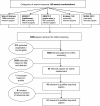Implementation factors and their effect on e-Health service adoption in rural communities: a systematic literature review
- PMID: 23311452
- PMCID: PMC3575225
- DOI: 10.1186/1472-6963-13-19
Implementation factors and their effect on e-Health service adoption in rural communities: a systematic literature review
Abstract
Background: An ageing population is seen as a threat to the quality of life and health in rural communities, and it is often assumed that e-Health services can address this issue. As successful e-Health implementation in organizations has proven difficult, this systematic literature review considers whether this is so for rural communities. This review identifies the critical implementation factors and, following the change model of Pettigrew and Whipp, classifies them in terms of "context", "process", and "content". Through this lens, we analyze the empirical findings found in the literature to address the question: How do context, process, and content factors of e-Health implementation influence its adoption in rural communities?
Methods: We conducted a systematic literature review. This review included papers that met six inclusion and exclusion criteria and had sufficient methodological quality. Findings were categorized in a classification matrix to identify promoting and restraining implementation factors and to explore whether any interactions between context, process, and content affect adoption.
Results: Of the 5,896 abstracts initially identified, only 51 papers met all our criteria and were included in the review. We distinguished five different perspectives on rural e-Health implementation in these papers. Further, we list the context, process, and content implementation factors found to either promote or restrain rural e-Health adoption. Many implementation factors appear repeatedly, but there are also some contradictory results. Based on a further analysis of the papers' findings, we argue that interaction effects between context, process, and content elements of change may explain these contradictory results. More specifically, three themes that appear crucial in e-Health implementation in rural communities surfaced: the dual effects of geographical isolation, the targeting of underprivileged groups, and the changes in ownership required for sustainable e-Health adoption.
Conclusions: Rural e-Health implementation is an emerging, rapidly developing, field. Too often, e-Health adoption fails due to underestimating implementation factors and their interactions. We argue that rural e-Health implementation only leads to sustainable adoption (i.e. it "sticks") when the implementation carefully considers and aligns the e-Health content (the "clicks"), the pre-existing structures in the context (the "bricks"), and the interventions in the implementation process (the "tricks").
Figures
Similar articles
-
Factors that influence parents' and informal caregivers' views and practices regarding routine childhood vaccination: a qualitative evidence synthesis.Cochrane Database Syst Rev. 2021 Oct 27;10(10):CD013265. doi: 10.1002/14651858.CD013265.pub2. Cochrane Database Syst Rev. 2021. PMID: 34706066 Free PMC article.
-
How lived experiences of illness trajectories, burdens of treatment, and social inequalities shape service user and caregiver participation in health and social care: a theory-informed qualitative evidence synthesis.Health Soc Care Deliv Res. 2025 Jun;13(24):1-120. doi: 10.3310/HGTQ8159. Health Soc Care Deliv Res. 2025. PMID: 40548558
-
Gender differences in the context of interventions for improving health literacy in migrants: a qualitative evidence synthesis.Cochrane Database Syst Rev. 2024 Dec 12;12(12):CD013302. doi: 10.1002/14651858.CD013302.pub2. Cochrane Database Syst Rev. 2024. PMID: 39665382
-
Health professionals' experience of teamwork education in acute hospital settings: a systematic review of qualitative literature.JBI Database System Rev Implement Rep. 2016 Apr;14(4):96-137. doi: 10.11124/JBISRIR-2016-1843. JBI Database System Rev Implement Rep. 2016. PMID: 27532314
-
Systemic pharmacological treatments for chronic plaque psoriasis: a network meta-analysis.Cochrane Database Syst Rev. 2021 Apr 19;4(4):CD011535. doi: 10.1002/14651858.CD011535.pub4. Cochrane Database Syst Rev. 2021. Update in: Cochrane Database Syst Rev. 2022 May 23;5:CD011535. doi: 10.1002/14651858.CD011535.pub5. PMID: 33871055 Free PMC article. Updated.
Cited by
-
Understanding Medical Students' Attitudes Toward Learning eHealth: Questionnaire Study.JMIR Med Educ. 2020 Oct 1;6(2):e17030. doi: 10.2196/17030. JMIR Med Educ. 2020. PMID: 33001034 Free PMC article.
-
The telemedicine community readiness model-successful telemedicine implementation and scale-up.Front Digit Health. 2023 Feb 23;5:1057347. doi: 10.3389/fdgth.2023.1057347. eCollection 2023. Front Digit Health. 2023. PMID: 36910573 Free PMC article.
-
Rates, Barriers, and Facilitators of Outcome Collection on Hand Surgery Outreach to Low- and Middle-Income Countries.Hand (N Y). 2023 Jul;18(5):875-884. doi: 10.1177/15589447211072200. Epub 2022 Jan 20. Hand (N Y). 2023. PMID: 35048744 Free PMC article.
-
m-Health Policy Readiness and Enabling Factors: Comparisons of Sub-Saharan Africa and Organization for Economic Cooperation and Development Countries.Telemed J E Health. 2018 Nov;24(11):908-921. doi: 10.1089/tmj.2017.0278. Epub 2018 Feb 12. Telemed J E Health. 2018. PMID: 29432073 Free PMC article.
-
A rural teledentistry care experience: a geriatric approach to assessing oral health status and treatment needs in older adults from a Mapuche community in Chile.Front Public Health. 2024 Jun 5;12:1356622. doi: 10.3389/fpubh.2024.1356622. eCollection 2024. Front Public Health. 2024. PMID: 38903581 Free PMC article.
References
-
- United Nations Department of Economic and Social Affairs Population Division. New York: World population ageing; 2009.
-
- OECD. Society at a Glance, OECD-Social Indicators. Paris: OECD Publishing; 2009.
-
- Marsden T. Rural futures: Countryside and its regulation. Sociol Rural. 1999;39(4):501–520. doi: 10.1111/1467-9523.00121. - DOI
-
- Fésüs G, Rillaers A, Poelman H, Gáková Z. Regions 2020: Demographic challenges for European regions, Commission of European communities. 2020. http://ec.europa.eu/regional_policy/sources/docoffic/working/regions2020....
Publication types
MeSH terms
LinkOut - more resources
Full Text Sources
Other Literature Sources
Medical
Research Materials
Miscellaneous



